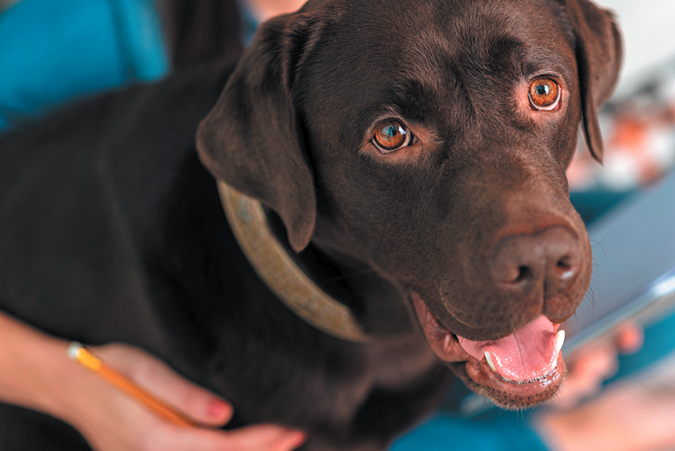Has your dog been squinting more than usual? Is at least one of his eyes red? And is there some mucous discharge from one or both eyes — not the grey, jelly-like ooze that you can easily wipe away but something thicker and perhaps more yellowish as well as harder to remove? If so, get your dog to the veterinarian. There’s a reasonable chance he is not producing enough tears and has a condition called dry eye, known in medical circles as kerato-conjunctivitis sicca. It’s a fairly common illness among dogs that can lead to impaired vision if not diagnosed and treated.
The eye has to be able to produce enough tears to make a film that covers the cornea — the transparent covering of the eye’s colored iris and pupil. That film is a fundamental layer of normal eye anatomy. If it loses thickness, the condition will cause problems with sight and can make a dog feel very uncomfortable. “Any level of dryness is associated with blurrier vision,” says Stefano Pizzirani, PhD, DVM, a veterinary ophthalmologist at Tufts Cummings School. “In addition,” he adds, “if a case becomes advanced enough, an irreversible deposit of black pigment over the corneal surface may occur.”
Diagnosis
Sign of dry eye, especially in its early stages, may go unnoticed by many owners. A dog’s doctor may be more likely to pick them up during a routine wellness exam. He will confirm the diagnosis with what is called a Schirmer Tear Test. Specifically, he will insert the sterile tip of a specially designed paper strip into the inside of the lower lid and hold it there for 1 minute. The strip will become wet to a certain length depending on tear production. A normal value is at least 15 millimeters in length per minute. Early stages of dry eye are between 10 and 15 — not usually evident to most owners. More evident clinical signs occur when values are below 10, and in severe cases, below 5.
Effective treatments available
As dry eye often results from a glitch in the immune system that makes it react against the lacrimal glands that produce tears, immune-suppressing drugs are a first line of defense. The most commonly prescribed are tacrolimus and cyclosporine. Both medications are administered as drops or ointments that need to be applied to the eye up to two or three times daily.
An over-the-counter formulation of cyclosporine that is less concentrated is also available; it is usually used in the early stages of dry eye.
An important adjunctive treatment comes in the form of artificial tears. “High-viscosity drops are important because they stay on the eye longer than other formulations,” Dr. Pizzirani says. That helps with owner compliance, he comments, because they allow for less frequent application.
It should be noted that no matter how early in the disease process you start administering medication, it cannot restore 100 percent of the function of the lacrimal gland that produces tears naturally. “The amount and severity of the damage to the gland will vary,” Dr. Pizzirani says, “but there will always be some amount of incurable damage in the form of scarring before treatment begins. Still, if the diagnosis is made in the early stages, the response to therapy is usually quite satisfactory.”
You have to apply the immune suppressants for the rest of the dog’s life. If the drugs are at any point discontinued or the frequency of their applications reduced, the condition worsens. Medication can control but not cure it.
Breeds Predisposed to Dry Eye
A dog of any breed, including mixed breed dogs, can end up with dry eye. But the following breeds are predisposed to the condition:
-Lhasa apso
-Shih Tzu
-English bull dog
-Cavalier King Charles spaniel
-Pug
-American cocker spaniel
-West Highland white terrier
-Boston terrier
Many of these breeds are brachycephalic, meaning they have shortened muzzles and very prominent eyes that are more exposed to tear evaporation, especially with aging. These breeds also often have a decreased blinking rate or incomplete blinking; blinking is what spreads tears over the cornea in a smooth film.
The most common underlying cause of dry eye is an autoimmune disease that affects the tear-producing lacrimal glands, although congenital malformations, neurological problems, and endocrine diseases like hyperthyroidism may also be responsible.





